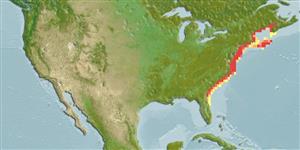Environment: milieu / climate zone / depth range / distribution range
Écologie
marin; eau douce; saumâtre démersal; anadrome (Ref. 51243); profondeur 6 - 53 m (Ref. 93286), usually 6 - 34 m (Ref. 93286). Subtropical; 49°N - 28°N, 82°W - 65°W (Ref. 54259)
North America: St. John River in Canada to St. Johns River in Florida, USA.
Length at first maturity / Taille / Poids / Âge
Maturity: Lm 50.0, range 45 - 55 cm
Max length : 143 cm TL mâle / non sexé; (Ref. 6866); common length : 50.0 cm TL mâle / non sexé; (Ref. 12193); poids max. publié: 23.0 kg (Ref. 6866); âge max. reporté: 67 années (Ref. 6866)
Épines dorsales (Total): 0; Rayons mous dorsaux (Total): 33-42; Épines anales 0; Rayons mous anaux: 18 - 24. Snout short, bluntly V-shaped, not upturned at tip. Barbels short (Ref. 7251). Absence of fontanelle and post dorsal shields. Single row of pre anal shields, 6-11 (Ref. 4639). Dorsal shields 7-13, lateral shields 22-34 (Ref. 4639). Blackish viscera (Ref. 37032). Head and back dark, lower surface white (Ref. 37032). Anal fin origin beneath dorsal fin origin (Ref. 86798).
Inhabit river mouths, lakes, estuaries, and bays; occasionally enters the open sea. Feeds mostly at night over soft substrates; juveniles feed primarily on benthic crustaceans and insects, adults prey on benthic crustaceans, insects and mollusks (Ref. 93252). Maximum known age is 67 years for females and 30 years for males. Flesh of good quality; eggs are suitable for caviar (Ref. 3192).
Page, L.M. and B.M. Burr, 1991. A field guide to freshwater fishes of North America north of Mexico. Houghton Mifflin Company, Boston. 432 p. (Ref. 5723)
Statut dans la liste rouge de l'IUCN (Ref. 130435)
Menace pour l'homme
Harmless
Utilisations par l'homme
Pêcheries: intérêt commercial mineur; pêche sportive: oui; Aquarium: Aquariums publics
Plus d'informations
RéférencesAquacultureProfil d'aquacultureSouchesGénétiqueElectrophoresesHéritabilitéPathologiesTraitementNutrientsMass conversion
CollaborateursImagesStamps, Coins Misc.SonsCiguateraVitesseType de nageSurface branchialeOtolithesCerveauxVision
Outils
Articles particuliers
Télécharger en XML
Sources Internet
Estimates based on models
Preferred temperature (Ref.
123201): 7.5 - 25.5, mean 15.6 °C (based on 138 cells).
Phylogenetic diversity index (Ref.
82804): PD
50 = 0.5000 [Uniqueness, from 0.5 = low to 2.0 = high].
Bayesian length-weight: a=0.00324 (0.00142 - 0.00736), b=3.17 (2.99 - 3.35), in cm total length, based on LWR estimates for this Genus-body shape (Ref.
93245).
Niveau trophique (Ref.
69278): 3.3 ±0.39 se; based on food items.
Résilience (Ref.
120179): Très faible, temps minimum de doublement de population supérieur à 14 ans (K=0.04; tm=14-17; tmax=67; Fec=48,000).
Fishing Vulnerability (Ref.
59153): Very high vulnerability (86 of 100).
